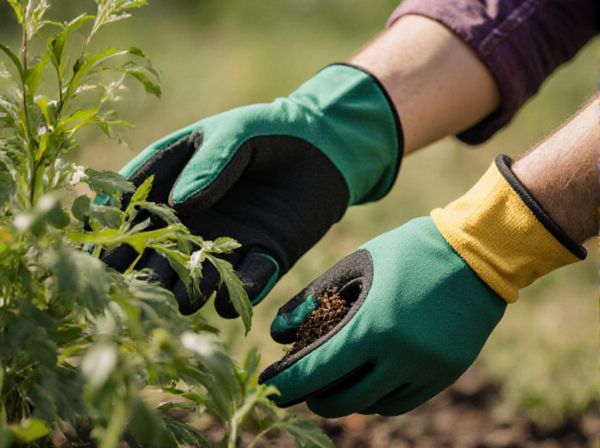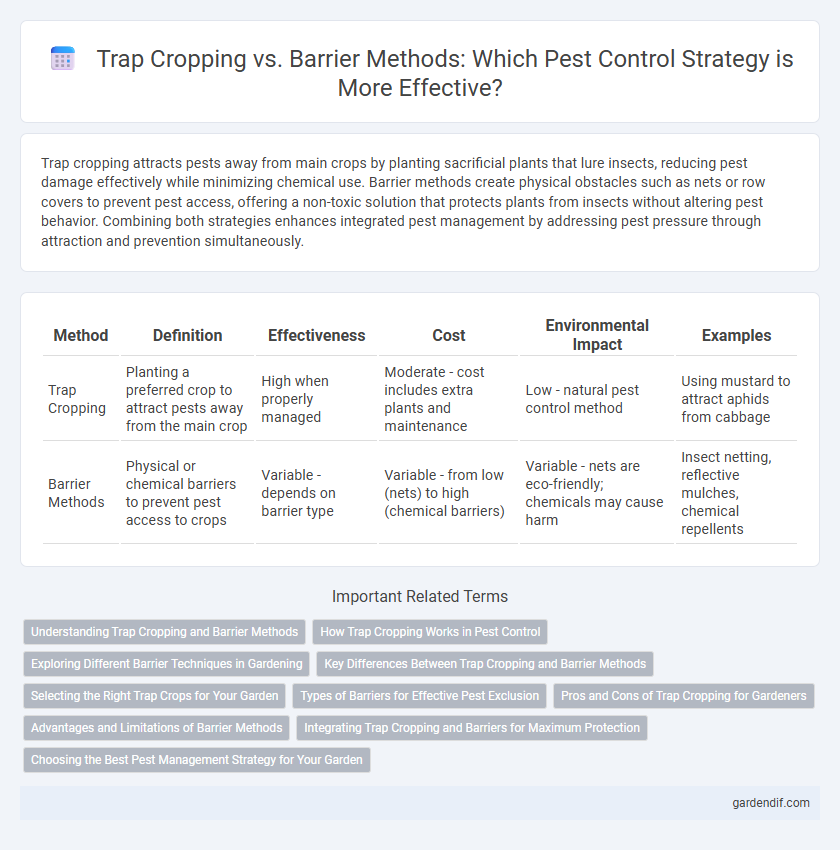
trap cropping vs barrier methods Illustration
Trap cropping attracts pests away from main crops by planting sacrificial plants that lure insects, reducing pest damage effectively while minimizing chemical use. Barrier methods create physical obstacles such as nets or row covers to prevent pest access, offering a non-toxic solution that protects plants from insects without altering pest behavior. Combining both strategies enhances integrated pest management by addressing pest pressure through attraction and prevention simultaneously.
Table of Comparison
| Method | Definition | Effectiveness | Cost | Environmental Impact | Examples |
|---|---|---|---|---|---|
| Trap Cropping | Planting a preferred crop to attract pests away from the main crop | High when properly managed | Moderate - cost includes extra plants and maintenance | Low - natural pest control method | Using mustard to attract aphids from cabbage |
| Barrier Methods | Physical or chemical barriers to prevent pest access to crops | Variable - depends on barrier type | Variable - from low (nets) to high (chemical barriers) | Variable - nets are eco-friendly; chemicals may cause harm | Insect netting, reflective mulches, chemical repellents |
Understanding Trap Cropping and Barrier Methods
Trap cropping involves planting specific crops that attract pests away from the main crop, effectively reducing pest damage and minimizing pesticide use. Barrier methods create physical or chemical obstacles to prevent pests from reaching the plants, enhancing crop protection through non-invasive means. Both strategies target pest management by exploiting pest behavior or movement patterns for sustainable agricultural practices.
How Trap Cropping Works in Pest Control
Trap cropping works in pest control by planting specific crops that attract pests away from the main crop, effectively reducing pest populations on valuable plants. These trap crops serve as a sacrificial area where pests concentrate, allowing for easier monitoring and targeted pest management tactics such as localized pesticide application. This method enhances ecological pest control by minimizing chemical use and protecting the primary crop from damage.
Exploring Different Barrier Techniques in Gardening
Exploring different barrier techniques in gardening reveals that trap cropping and physical barriers serve distinct pest management roles; trap crops attract pests away from main plants, while barrier methods like row covers, netting, and collars prevent pest access directly. Row covers offer breathable protection against insects, mesh netting deters larger pests such as birds and rabbits, and plant collars stop cutworms and beetles at the stem base. Combining these barrier techniques with trap cropping enhances integrated pest management, reducing chemical pesticide reliance and promoting healthier garden ecosystems.
Key Differences Between Trap Cropping and Barrier Methods
Trap cropping involves planting specific crops that attract pests away from the main crop, effectively luring pests into a controlled zone where they can be managed or eliminated. Barrier methods create physical or natural obstructions such as nets, fences, or plant barriers that prevent pests from reaching the primary crops. The key difference lies in trap cropping's strategy of pest attraction versus barrier methods' emphasis on pest exclusion, influencing their application based on pest behavior and crop type.
Selecting the Right Trap Crops for Your Garden
Selecting the right trap crops for your garden involves choosing plants that specifically attract the target pest, which can effectively divert them away from your main crops. Popular trap crops include mustard for aphids, marigolds for whiteflies, and nasturtiums for aphids and flea beetles, providing a natural pest management strategy. Combining trap cropping with barrier methods like physical barriers or row covers enhances pest control by reducing pest access and concentration on valuable plants.
Types of Barriers for Effective Pest Exclusion
Physical barriers such as fine mesh nets, row covers, and plastic sheeting serve as effective pest exclusion methods by preventing insect entry while allowing air and light penetration. Chemical barriers utilize repellent sprays or treated fabrics to deter pests from approaching crops, reducing infestation risks. Combining multiple barrier types enhances protection against a broad spectrum of pests by creating an integrated defense system tailored to specific pest behaviors and crop requirements.
Pros and Cons of Trap Cropping for Gardeners
Trap cropping attracts pests away from main crops by planting sacrificial plants, reducing pesticide use and promoting healthier garden ecosystems. It requires careful selection and placement of trap crops, which may demand extra space and management, posing a challenge for small gardens. While effective for specific pests, inconsistent pest attraction can limit trap cropping's reliability compared to physical barrier methods.
Advantages and Limitations of Barrier Methods
Barrier methods provide an effective physical means to protect crops by preventing pests from reaching plants, significantly reducing pest infestation without chemical use. These methods offer advantages such as targeted pest exclusion and minimal environmental impact but have limitations including high initial setup costs, maintenance requirements, and potential interference with pollinators or beneficial insect movement. Effective deployment of barrier methods requires careful crop-specific planning to balance pest control benefits against these operational challenges.
Integrating Trap Cropping and Barriers for Maximum Protection
Integrating trap cropping and barrier methods enhances pest management by leveraging the attractant properties of trap crops to divert pests away from main crops while physical barriers prevent pest entry. This combined approach reduces pesticide use and increases crop yield by creating a multi-layered defense system tailored to specific pest behaviors and movement patterns. Field studies show that synergistic use of traps and barriers results in significantly lower pest infestations compared to single-method strategies.
Choosing the Best Pest Management Strategy for Your Garden
Trap cropping involves planting specific crops that attract pests away from main crops, effectively reducing pest damage through targeted attraction and containment. Barrier methods use physical obstacles like nets, row covers, or fences to prevent pests from reaching plants, providing a direct and chemical-free protection. Selecting the best pest management strategy depends on the pest species, crop type, garden size, and environmental conditions to balance effectiveness, cost, and sustainability.
trap cropping vs barrier methods Infographic

 gardendif.com
gardendif.com